Destination: Washington D.C.
For some real bipartisan bassin', look no further than the friendly aquatic confines of the nation’s capital
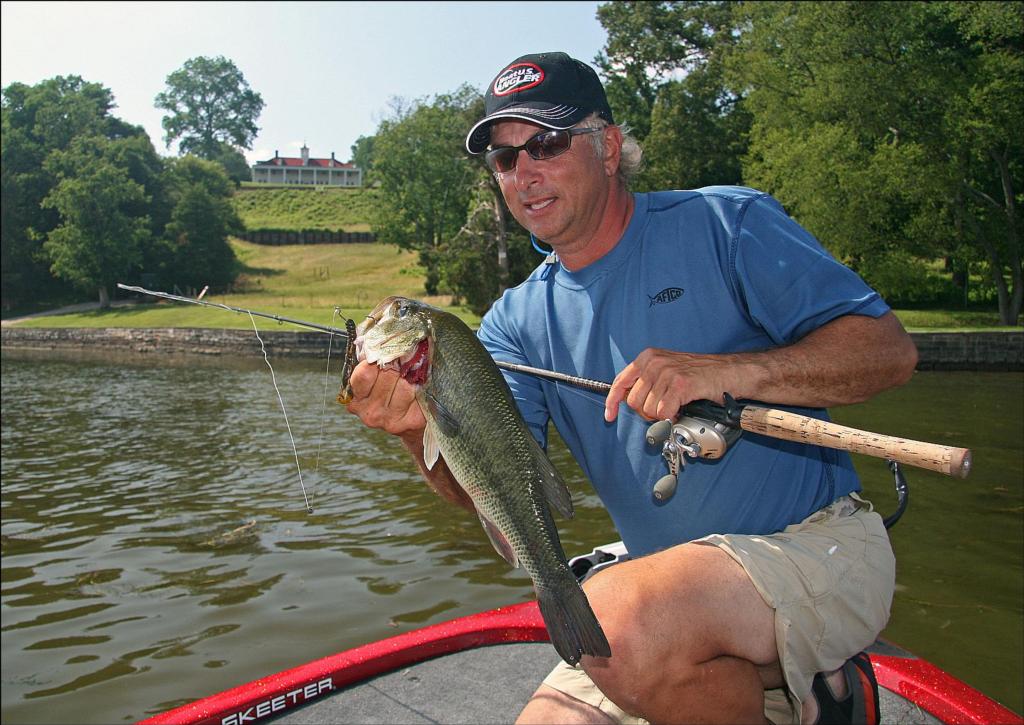
Rare is the case when Washington D.C. finds Democrats and Republicans seeing eye-to-eye. However, both parties can agree that the historic waters of the Potomac River offer tremendous angling opportunity within close proximity to the U.S. capital.
Nicknamed “the Nation’s River” for its Civil War importance, its proximity to the D.C. area and birthplace/home of George Washington, the Potomac holds plenty of catfish, panfish and those aggressive exotics known as snakeheads. But the star of the show is the largemouth bass. Quality largemouth bass action occurs well north of the Woodrow Wilson Bridge – often within clear eyesight of D.C. landmarks such as the Washington Monument and Jefferson Memorial. Anglers might also pose for a souvenir photo with the Capitol Building, Pentagon or the infamous Watergate Hotel behind their big catch.
A highly reputable bass fishery may surprise those who recall the Potomac’s dirtier days. However, intense cleanup efforts over the past 40-plus years have given the river a new lease on life and spurred a vibrant fishing scene strong enough to attract tournament competition.
“The perception is that the river is muddy and polluted,” said Capt. Steve Chaconas, whose National Guide Service bespeaks the area’s angling marketability. “It used to be, but since the Clean Water legislation (took effect) in the late 1960s, and with the introduction of sub-aquatic vegetation, the largemouth bass population has boomed. This is now a high level bass fishery.
“This river’s bass population is a tribute to how well we can reverse decades of bad practices and clean up a once dead fishery. In addition, the catch-and-release ethic and good fish handling by the major tournament trails like FLW Outdoors demonstrates the effectiveness of these efforts.”
Politicians and pundits frequent the Potomac’s parks and jogging trails, so don’t be surprised to spot some of the faces common to network and cable news programs. But if the mossback monster tops your list, this river rarely disappoints.
Finding the fish
The Potomac presents plenty of hard cover like docks, logs and laydowns, while the river’s many creeks offer consistent potential, especially in their outer bays. Chaconas likes Broad, Piscataway, Aquia and Potomac creeks for spring spawners, while Nanjemoy Creek gets his vote for big summer bags. Mattawoman Creek, about halfway down the river from D.C., is always a good spring through fall bet. During winter, Potomac fish seek deep, warm water out of the current like the cozy digs found at National Harbor (south of the Wilson Bridge) and the balmy discharge at D.C.’s water treatment plant at Blue Plains.
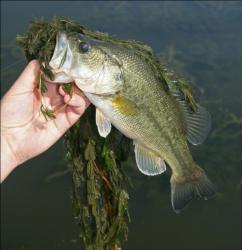 Spring-Summer simplifies the hunt for Potomac fishermen, as most of the action occurs in and around aquatic weed beds. Hydrilla and milfoil comprise the majority of grass beds and this is where you find the most shelter and the most food. Accordingly, it’s where you find the most bass.
Spring-Summer simplifies the hunt for Potomac fishermen, as most of the action occurs in and around aquatic weed beds. Hydrilla and milfoil comprise the majority of grass beds and this is where you find the most shelter and the most food. Accordingly, it’s where you find the most bass.
“One of the great things about the Potomac, if there’s grass, there are bass and just about any stretch will hold fish,” Chaconas said.
Thomas Wooten of Huddleston, Va. placed third in this year’s FLW American Fishing Series Northern Division event on the Potomac. He likes to pull away from large stretches of grass and target isolated clumps that receive less pressure. The fish may come and go with the tide, but diligently probing various spots can reveal a gold mine.
Topping the AFS event, Maryland pro Bryan Schmidt makes distance his ally during the post-spawn through summer period by fishing grass edges farthest from shore. He believes the larger females move way out to the main river grass beds where the combination of lower fishing pressure and maximum tidal flow keeps the big gals cozy and active.
The grass grows along narrow flats off much of the D.C. waterfront, but the massive grass flats where bass fishing abounds begin just south of the Woodrow Wilson Bridge – part of the Capital Beltway. The D.C. area also offers a lot of deeper fishing around bridge pilings – a great winter option; but as Chaconas notes, one with predictable encumbrance.
“The biggest reason I don’t fish (in front of D.C.) a lot is the increased security since 9/11,” he said. “There are a lot of Coast Guard, Homeland Security and D.C. Harbor patrols and getting stopped while fishing around bridges, in front of Ronald Reagan Washington National Airport and the Pentagon is almost a sure thing. Searches can take 30 minutes or more.”
If you don’t mind the prospect of a security check, fishing in the capital’s backyard holds legitimate potential. However, waters within a short run of the security zone offer even greater opportunities. Hailing from Alexandria, Va., Chaconas favors the expansive grass beds flanking the picturesque Mount Vernon – former home of George Washington (see: “History on the Hill” below).
Timing the tides
Formed by the convergence of a North Branch originating in West Virginia and a South Branch in Virginia, the Potomac River flows some 383 miles to Chesapeake Bay between Point Lookout, Md., and Smith Point, Va. After the river transitions from the Piedmont Plateau to the coastal plain, Chesapeake tides bear significant influence from the D.C. area southward.
An often dumbfounding element for freshwater anglers, tides can just as easily scramble the best of game plans, or deliver a continuous bounty. The key to grasping the tidal concept is actually very simple: predictable patterns will arise each day, but they won’t remain for long. The fish and their forage will move up the tidal range on rising water and retreat backward with the leaving tide. Find the productive scenarios and keep advancing or retreating with the fish.
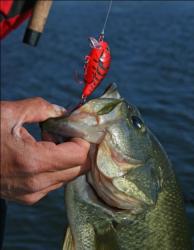 Timing is critical in this feast-or-famine scenario. Miss the deal by 30 minutes and you’ll starve on the wrong end of that metaphor. Get it right and you’ll be deep in the bites.
Timing is critical in this feast-or-famine scenario. Miss the deal by 30 minutes and you’ll starve on the wrong end of that metaphor. Get it right and you’ll be deep in the bites.
Furthermore, Chaconas advises anglers to respect the tide’s conditional influence. “Tides do more than raise and lower the water level, they bring in cooler and warmer water along with clear or muddy water. They also position the fish on edges or in down-current sides of cover.
“Generally, as the tide comes in, the fish move into the cover or toward the shoreline. Conversely as the water pulls out, fish move to the outer edge of cover, like grass edges or ends of docks and laydowns. It’s best to take an in-and-out approach to large grass beds until a pattern is developed rather than just an edge-oriented tack.”
Optimal tactics
Tide-savvy anglers often fare well by fishing the edges of offshore grass with crankbaits, spinnerbaits and chatterbaits during low water and then working their way into the vegetation when a rising tide permits. Through incoming and high water, fish Texas-rigged worms, tubes and creature baits – either pitched into gaps or punched right through the slop for fish lounging beneath the canopy.
For his grass duties, Schmitt flips a homemade 3/8-ounce black-and-blue jig with a Zoom Super Chunk trailer. Wooten also likes a jig, but he goes with the swimming style and runs it along grass edges. In active areas, he’ll follow up by flipping a Reaction Innovations Sweet Beaver.
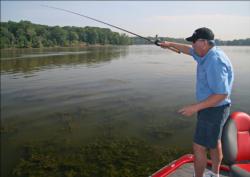 Hollow body frogs are a must for the grass angler’s arsenal and popping models can be deadly – especially when baitfish gather near the surface. Simulating their nervous splashing will bring a hungry pass charging topside.
Hollow body frogs are a must for the grass angler’s arsenal and popping models can be deadly – especially when baitfish gather near the surface. Simulating their nervous splashing will bring a hungry pass charging topside.
“Even if there isn’t a fish (immediately) chasing the bait, that activity will attract bass,” Chaconas said.
For maximum topside display, a sputtering buzzbait will bring out the beast in a river bass – especially when early morning or cloudy days find them roaming around grass edges. When the fish play hard to get, drop a wacky-rigged Senko or a flick shake finesse worm and wiggle it into an open spot in the grass.
Summer success on the Potomac lies well within reach even for first-timers. Like the nearby political epicenter, you just have to know the power brokers and understand their game. On this river, fortune pivots on the whims of the tide and the labyrinthine tangles of aquatic vegetation. Get it right and you’re in for a bipartisan big time.
Angler access
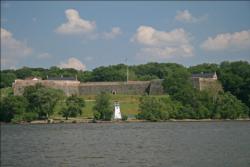 Boaters targeting the Washington D.C. area can launch at:
Boaters targeting the Washington D.C. area can launch at:
Belle Haven Marina – George Washington Memorial Pkwy., south of Woodrow Wilson Bridge in Alexandria, Va.
Gravely Point – George Washington Memorial Pkwy., north of Ronald Reagan Washington National Airport in Arlington, Va.
National Harbor – Just south of Woodrow Wilson Bridge in Prince George’s County, Md. (Hosting FLW Tour Open event June 1-4, 2011.)
Fort Washington Marina – King Charles Terrace, Ft. Washington, Md.
For Potomac fishing information and guidance, contact Capt. Steve Chaconas at (703) 380-7119 or visit him at Nationalbass.com
History on a Hill
He’s best known as the Father of the Nation, but George Washington’s fascinating life encompassed a brilliant military career well before his mainstream notoriety. Between Potomac fishing trips, learn about the first U.S. president’s adventures and achievements, as well as his entrepreneurial endeavors at his former home, the 500-acre Mount Vernon Estate and Gardens.
Perched on a hill overlooking the river, the property operates under the private, non-profit ownership of the Mt. Vernon Ladies Association, which was founded in 1853 to rescue the estate from disrepair. Today, Mount Vernon holds 20 structures and 50 acres of gardens as they existed in the late 1700s, along with a museum, the tombs of George and Martha Washington, an outdoor exhibit devoted to American agriculture of Washington’s era and the nation’s most important memorial to the accomplishments of 18th-century slaves. Visitors can enjoy regional cuisine with colonial ambiance at the Mount Vernon Inn Restaurant.
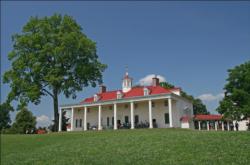 Three miles south of the Mount Vernon Estate, the reconstruction of George Washington’s Distillery and Gristmill demonstrates 18th Century methods for concocting Washington’s rye whiskey as well as demonstrations on flour production. A few miles farther south along State Road 235, visitors find the 126-acre Woodlawn estate. Originally part of the Mount Vernon property, Woodlawn was built in 1805 for George Washington’s nephew Lawrence Lewis and step-granddaughter Eleanor “Nellie” Custis. In 1952, Woodlawn became the first historic site owned by The National Trust for Historic Preservation.
Three miles south of the Mount Vernon Estate, the reconstruction of George Washington’s Distillery and Gristmill demonstrates 18th Century methods for concocting Washington’s rye whiskey as well as demonstrations on flour production. A few miles farther south along State Road 235, visitors find the 126-acre Woodlawn estate. Originally part of the Mount Vernon property, Woodlawn was built in 1805 for George Washington’s nephew Lawrence Lewis and step-granddaughter Eleanor “Nellie” Custis. In 1952, Woodlawn became the first historic site owned by The National Trust for Historic Preservation.
Located 16 miles south of Washington, D.C., on the Potomac’s west bank, Mount Vernon sits at the southern end of the George Washington Memorial Parkway. For information, visit
MountVernon.org
Bus routes run daily from D.C. and the Spirit of Mount Vernon cruise ship sails daily from Pier 4 at 6th & Water Streets SW, Washington, DC. For more information, visit CruisetoMountVernon.com. National Harbor also offers a shuttle service to and from Mount Vernon. For more information, visit Nationalharbor.com .